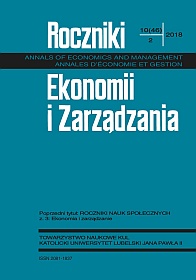The Shadow Economy – the Public Finance Sector and the Social Insurance System – Feedback
Abstract
The assumption of the article is the hypothesis that between the size of the shadow economy and the amount of tax rates and insurance premiums there is a reverse feedback – higher financial burdens increase the scope of the shadow economy. However, this hypothesis could not be verified positively on statistical data and shadow economy estimates. The size of the shadow economy is influenced by – apart from the high taxes and insurance premiums that do not encourage legal activity – much more factors, including a strong state and developed social awareness (tax morality) about the absolute necessity and need to bear tax and insurance burdens.
References
Cichocki S., Metody pomiaru szarej strefy, „Gospodarka Narodowa” 2006, nr 1-2.
European System of Accounts. ESA 2010, Komisja Europejska, 2013.
Feige L.E., How Big Is the Irregular Economy?, “Challenge” 22(1979), No. 5.
Frey S.B., Hanneman-Weck H., The Hidden Economy as an „Unobserved” Variable, “European Economic Review” 26(1984), No. 1-2.
Fundowicz J., Łapiński K., Peterlik M., Wyżnikiewicz B., Szara strefa w polskiej gospodarce w 2016 roku, Warszawa 2016, http://www.ibngr.pl/content/download/2173/20176/file/Szara%20strefa%202016.pdf [dostęp: 3.05.2018].
Kaufmann D., Kaliberda A., Integrating the Inoficial Economy into the Dynamic of Post Social Economies, “Working Paper” 1691, World Bank, Washington 1996.
Krzywa Laffera – podatki a dochody budżetu państwa, https://www.finanse21.pl/krzywa-laffera-podatki-a-dochody-budzetu-panstwa.html [dostęp: 3.03.2018].
Lackó M., Hidden Economy – An Unknown Quantity? Comparative Analysis of Hidden Economies in Transition Countries in 1989-1995, “Working Paper” 9905, University of Linz, Linz 1999.
Loayza N.V., The Economics of the Informal Sector: A Simple Model and Some Empirical Evidence from Latin America, “Carnegie-Rochester Conference Series on Public Policy” 1996, No. 45.
Measuring the Non-Observed Economy: A Handbook, OECD, Paris 2002.
Medina L., Schneider F., Shadow Economies Around the World: What Did We Learn Over the Last 20 Years?, “IMF Working Paper” 2018, WP/18/17.
Pauch D., Zjawisko szarej strefy w gospodarce, „Zeszyty Naukowe Uniwersytetu Szczecińskiego. Finanse, Rynki Finansowe, Ubezpieczenia” 1(2015), nr 76.
Przeciwdziałanie szarej strefie w Polsce, The Global Compact, Network Poland, Warszawa 2016.
Schneider F., Estimating the Size of the Shadow Economies of Highly Developed Countries: Selected New Results, CESifo Dice Report 4/2016 (December), p. 44-53, https://www.cesifo-group.de/DocDL/dice-report-2016-4-schneider-december.pdf [dostęp: 3.05.2018].
Schneider F., The Influence of Public Institutions on the Shadow Economy: An Empirical Investigation for OECD Countries, “European Journal of Law and Economics” 2010, No. 6-3.
Schneider F., The Shadow Economy: An Essay, http://www.econ.jku.at/members/Schneider/files/publications/2014/ShadEc_2014.pdf [dostęp: 16.06.2014].
Schneider F., Buehn A., Montenegro C.E., New Estimates for the Shadow Economies all over the World, “International Economic Journal” 2010, No. 24 (4).
Schneider F., Enste H.D., Shadow Economies: Size, Causes and Consequence, “Journal of Economic Literature” 38(2000).
Schneider F., Williams C.C., The Shadow Economy, The Institute of Economic Affairs, London 2013.
Williams C.C., Schneider F., Measuring the Global Shadow Economy: The Prevalence of Informal Work and Labour, Edward Elgar Publishing, Cheltenham 2016.
Copyright (c) 2018 Roczniki Ekonomii i Zarządzania

This work is licensed under a Creative Commons Attribution-NonCommercial-NoDerivatives 4.0 International License.


